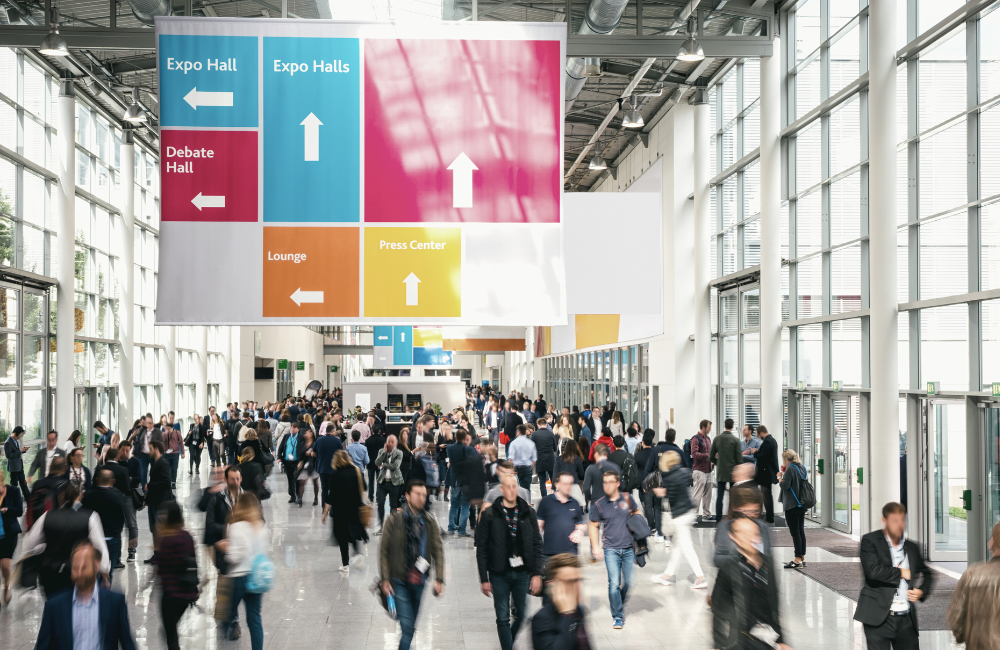It’s spring, which means it’s event season. Businesses across America (and around the world, for that matter) are dusting off their exhibits, unfurling their banners, erecting their pop-up signs, and preparing to hit the road.
In honor of this occasion, and to assist the novices and newcomers, we’ve assembled the following list of trade show and event terms—common phrases and labels you’re sure to hear from the various vendors and consultants you’ve enlisted to assist your efforts. Hopefully this list will prepare you for the inevitable conversations and allow you to communicate your objectives effectively.
To help organize this content, we’ve assigned the terms to six basic categories:

Introduction to Events
This section provides descriptions of trade show and event basics.
- Exhibit: The overall display or presentation created by a company for a trade show, including booths, banners, and promotional materials.
- Exhibit Hall: The main area of the venue where exhibitors set up their booths and attendees explore the various products and services. Sometimes call an Exposition (see below).
- Trade Show: An event where businesses from a particular industry showcase their products and services, creating important networking opportunities. Typically not open to the general public.
- Networking Event: A scheduled gathering designed to facilitate interactions and networking among attendees, exhibitors, and sponsors.
- Sponsorship: Financial support provided by a company in exchange for visibility and promotional opportunities at the event.
- Breakout Session: A smaller, specialized gathering within an event where participants can focus on specific topics or themes.
- Seminar: A lecture or presentation at an event, often involving audience interaction and discussion.
- Exposition: The portion of a trade show or conference where exhibitors display products or services related to the show theme. Sometimes called an Exhibit Hall (see above).
- VIP Lounge: An exclusive area where important guests or sponsors can network and relax.
- Trade Fair: Broadly, an international term used to describe an exposition.
- Foyer: A public area in a hotel or exhibit hall for assembly or registration.
- Hospitality Suite/Event: An area, separate from the exhibit hall, where refreshments are served and exhibitors can socialize with visitors. Most shows require hospitality events to take place after exhibit hours.
Logistics
This section describes terms related to event organization, planning, and set-up.
- Trade Show Organizer: The person or entity responsible for planning, managing, and executing a trade show.
- Event Planner: A professional responsible for organizing and coordinating events, including trade shows.
- Floor Plan: A map or layout of the trade show venue, indicating the location of booths, stages, and other key areas.
- B2B (Business-to-Business): Refers to companies that sell products or services to other businesses, a common focus in trade shows.
- B2C (Business-to-Consumer): Refers to companies that sell products or services directly to consumers.
- ROI (Return on Investment): The measurement of the profitability of participating in a trade show or event.
- Load-In and Load-Out: The process of setting up (load-in) and dismantling (load-out) the trade show exhibits and infrastructure.
- Security Plan: A comprehensive strategy outlining measures to ensure the safety and security of attendees, exhibitors, and the event venue.
- Exhibitor Services Manual: A comprehensive guide provided by show organizers to exhibitors containing important information, rules, and ordering forms for services such as electricity, internet, and booth furnishings.
- Scalability: The ability of the event to adapt and accommodate varying numbers of attendees or exhibitors.
- Load-Bearing Capacity: The maximum weight that the venue floor can support, important for planning exhibits and structures.
- Lead Retrieval System: A technology or software used by exhibitors to capture and manage leads obtained during the trade show.
- Dock Receipt: Issued by carriers to acknowledge delivery of a shipment at the carrier’s dock or warehouse facilities.
- Floor Manager: An individual representing show management who is responsible for the exhibition area.
- Height Limitation: Rules set by the show or floor manager to restrict the height of exhibits.
- Sponsorship Package: A customizable offering for companies interested in investing in additional exposure and branding opportunities.
Booth & Signage
This section provides an overview of basic display and other booth-related items.
- Booth; Booth Space: A designated assigned space within a trade show where a company sets up its displays and interacts with attendees. Sizes typically vary, with larger spaces costing more.
- Floor Marking: A method used to mark booth spaces.
- AV (Audio-Visual): Equipment and services related to sound, lighting, and visual presentations.
- Aisle Carpet: Carpet installed in aisles on the show floor.
- Aisle Signs: Signs (typically suspended from the ceiling) indicating aisle numbers for locating booths.
- Arch: An exhibit display ceiling or entryway which spans two points.
- Back Light: A light source that illuminates translucent material from behind.
- Backwall: The panels at the rear of an exhibit.
- Perimeter Booth: A booth located on the outer wall of the exhibit hall rather than adjacent to another exhibit. Also known as a backwall booth.
- Banner: A suspended panel used as a decoration or a sign, usually made of fabric or paper for temporary use.
- Canopy: Roof-type covering supported on pillars.
- Carpet Tape: Double-sided tape used to secure the edge of a carpet to the floor.
- Display: Graphic panel used to show a product or service. Sizes vary based on the booth.
- Elevations: Scaled drawings depicting front and side views of an exhibit.
- End Cap: An exhibit space or booth with aisles on three sides.
- Flat Cable: Special cables and extension cords used under the carpet to reduce tripping hazards and provide a more level booth floor.
- Free-Form Exhibit: An exhibit with aisles on all four sides for a 360-degree view. Also known as an Island Exhibit.
- Frontages: Describes an exhibit space’s width across the front. For instance, a 30’x10’ exhibit is 30 feet wide (the frontage) and 10 feet deep. Also known as Front Space.
- Full-Booth Coverage: Carpet that covers the entire booth space.
- Garment Rack: A metal frame used to support large numbers of apparel.
- Grommet: Rubber, metal, or plastic rings for reinforcing holes in weaker materials.
- Interactive Exhibits: Exhibits that include multimedia and integrated marketing elements to immerse visitors in an experience.
- Kiosk: A small informational counter, open on one or more sides, used for display purposes.
- Modular Exhibit: An exhibit constructed with interchangeable components.
- Peninsula Booth: A booth space with aisles on three sides. Also known as an End Cap.

- Stage: An elevated platform used for entertainment, speakers, or product demonstrations.
- Podium: Raised cabinet or lectern used to hold a speaker’s notes.
- Rental Booth: A turnkey booth package offered to exhibitors on a rental basis.
- Table-Top Display: Graphics or products designed for use on a table-top.
Pre-Event
Terms describing activities conducted prior to the show or event.
- Exhibit Prospectus: Promotional materials provided by the show sponsor to encourage and recruit prospective exhibitors.
- Floor Order: Orders for services placed after an exhibit installation has begun.
- Press Kit: Materials provided by show management to the media containing news releases, product announcements, and other materials.
- Registration Area: Check-in area for attendees where they receive badges for admittance.
- Space Assignment: The method of allocating space to exhibitors.
- Staging Area: An area set aside to prepare equipment prior to moving it to the show floor.
- Warehouse Storage: A location where crated freight can be stored.
- Direct Date: The first day that shipments may arrive at the exhibit site.
- Advance Receiving Date: Any time prior to or on the last day shipments may arrive at the advance warehouse without a surcharge.
- Drayage: The transportation of trade show materials from the loading dock to the exhibitor's booth, including handling and storage.
- Preshow Advance Order: Goods and/or services ordered prior to setup.
 At the Event
At the Event
Event-related phrases and topics.
- Traffic: The number of visitors who attend the event—a great indicator of whether it is worth your time and investment.
- Keynote Speaker: A featured speaker at an event, often an expert or notable figure.
- Badge: An identification card or tag that attendees wear to gain access to the event and various sessions.
- Badge Printing Station: An area where attendees can pick up their event badges upon arrival.
- Promotional Items: Branded merchandise such as pens, tote bags, or T-shirts that exhibitors hand out to promote their brand or products. Also known as “swag” (stuff we all get).
- Lead Generation: The process of collecting booth visitor contact information for future marketing and sales efforts.
- Access Panel: Removable sections of an exhibit permitting access to lamps, projectors, etc.
- Directory: A catalog of basic information about the show, including exhibitors, floor plan, and schedule of events. Sometimes referred to as an Onsite Program or just Program.
- Showcase: General term for an enclosure used to display objects. Also known as a Display Case.
- Toolkit: A box containing tools and supplies needed to repair an exhibit or product in the event of an emergency (a must-have for every exhibitor).
- Traffic Flow: Describes how attendees move through an exhibit or event.
After the Event
The following terms describe important post-event activities.
- Tear Down: The disassembly of an exhibit. Also known as Dismantle.
- Freight Desk: The area where inbound and outbound exhibit materials are handled at a trade show.
- Return Label: Used to return event material, usually back to a fulfillment house or office.
- Post-Event Evaluation: The process of gathering feedback to assess the success of the event and identifying potential areas for improvement.
OnFulfillment Can Help Manage Your Events, Start to Finish
If you’re just getting started on events, or if you could use some help organizing it all, OnFulfillment can help. We offer comprehensive event management services that help you plan and execute multiple in-person, virtual, or hybrid events simultaneously. We can take over the repetitive, tedious, and time-consuming tasks, allowing you to focus on more strategic and revenue-enhancing activities.


